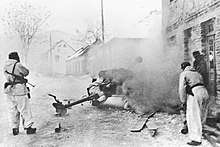Operation Kugelblitz
Operation Kugelblitz ("ball lightning") was a major anti-Partisan offensive orchestrated by German forces in December 1943 during World War II in Yugoslavia. The Germans attacked Josip Broz Tito's Partisan forces in the eastern parts of the Independent State of Croatia in an attempt to encircle and destroy them, thereby preventing the Partisans from entering the Territory of the Military Commander in Serbia. Operation Kugelblitz was followed up immediately by Operation Schneesturm (Blizzard) which sought to capitalise on the initial success of Operation Kugelblitz. Both operations are associated with the Sixth Enemy Offensive (Serbo-Croatian: Šesta neprijateljska ofenziva/ofanziva) in Yugoslav historiography.
The offensive
Operation Kugelblitz
Operation Kugelblitz, the first of the two offensives, was executed by the 5th SS Mountain Corps. The aim of this operation was to dismantle and consequently destroy Partisan units in eastern Bosnia. The plan, however, turned out to be was overly ambitious. German force assigned to this action were tasked with covering an overly large area, one not so easily controlled. The bulk of the Partisan force slipped through large gaps in the ever-narrowing ring. Despite this, the cost of Operation Kugelblitz was severe, with Partisan casualties claimed at approximately 9,000 casualties.
Operation Schneesturm
Operation Schneesturm was initiated immediately upon the completion of Operation Kugelblitz. This operation included twin drives from the Bosnia area. One drive headed westwards towards the Adriatic Sea. The other, headed to the northwest and towards the border with Italy. While this operation ended late in December and the Partisans once again survived, the cost was high. The Partisans suffered about 2,000 additional casualties. Though badly battered, the majority of the Partisan units retained their cohesion. Tito's army, in the opinion of some, could still be considered an effective fighting force.
Results
Such in general outline was the sixth offensive on liberated territory in Yugoslavia. The fact that British observers were by this time plentiful on the ground meant that the fighting was adequately reported abroad—as it had never been before—and the conclusion of the campaign coincided with a great wave of publicity for the partisans in England and the United States.[2]
For the Germans their sixth offensive was entirely inconclusive. They had failed to do more than merely interrupt the free development of the resistance movement, and although they burnt large numbers of villages and killed whomever they laid hands on they scarcely reduced the numbers of those who were fighting, and they laid the basis, indeed, for a great increase in those numbers. No reliable estimates of partisan casualties are available; and similarly it is impossible to do more than guess at German casualties. The only statement that can be made without fear of contradiction is that the ratio was heavily in favour of the partisans.[3]
References
- Roland Kaltenegger, The Mountain Troops of the Waffen-SS, 1941-1945, Schiffer Publishing, Limited, 1995, ISBN 0887408133, p. 21.
- Basil Davidson: PARTISAN PICTURE
- Basil Davidson: PARTISAN PICTURE
See also
- Military history of Bulgaria during World War II
- Seven anti-Partisan offensives
- Resistance during World War II
- Anti-partisan operations in World War II
